Products
-

2ml Grinding Tubes, Clear, DNase/RNase Free (500 Count)
SKU: HT-200-MFor tissue homogenizer The maximum centrifuge speed up to 18,000RCF RNase, DNase, DNA and Endotoxin-Free Autoclavable; Temperature range from -90oC to 121oC Thickeded wall for safe grinding A box of 500 tubes
$20.00
-
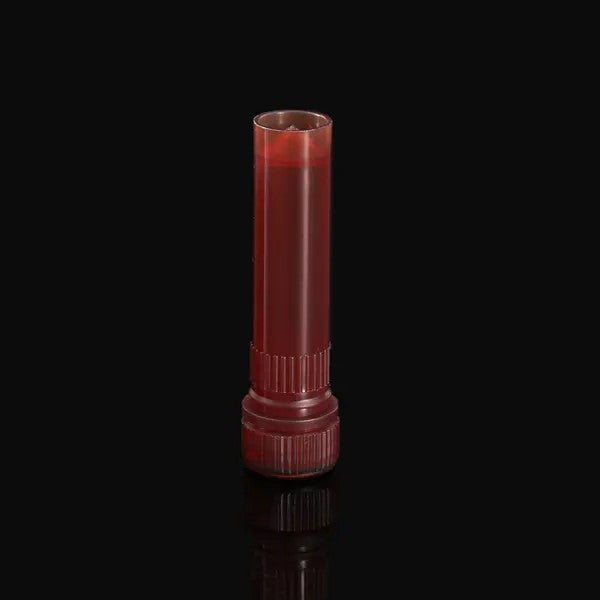
2ml Screw Cap Centrifuge Tubes, Sel-standing, Amber Color (500 Count)
SKU: TUBESC020-01EColor: Amber Clear Medical Grade Polypropylene; Autoclavable No detectable DNase, RNase, Proteins and DNA Tube Material: Polypropylene Non-sterile, autoclavable Caps with silicone O-rings included RCF up to 20,000 x G Working Temperature: -196°C to 121°C, Freeze Proof, Boil Proof
$60.00
-
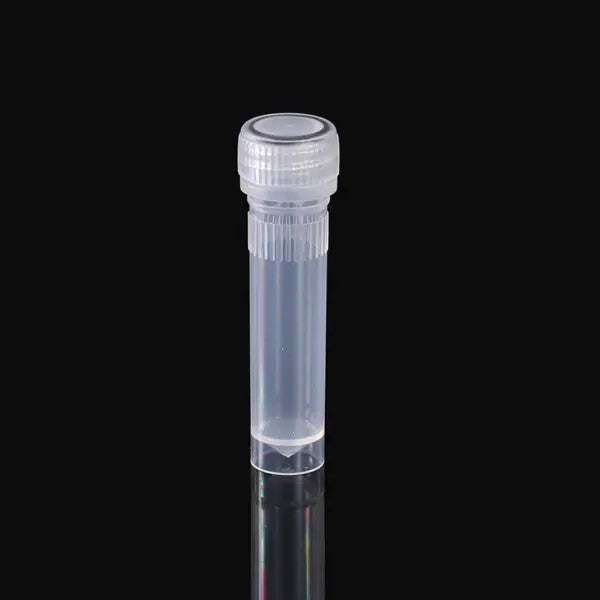
2ml Screw Cap Centrifuge Tubes, Self-Standing, Clear (500 Count)
SKU: TUBESC020-01CColor: Nature Clear Medical Grade Polypropylene; Autoclavable No detectable DNase, RNase, Proteins and DNA Tube Material: Polypropylene Non-sterile, autoclavable Caps with silicone O-rings included RCF up to 20,000 x G Working Temperature: -196°C to 121°C, Freeze Proof, Boil Proof
$50.00
-
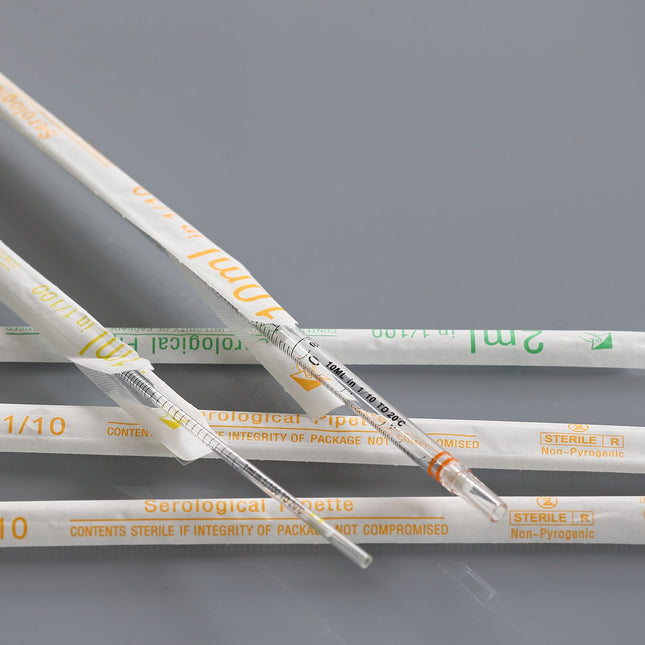
2ml Serological Pipets, Sterile, Individually Wrapped (400 Count)
SKU: 325001High clarity polystyrene Used in tissue culture and bacterial culture experiments One-piece construction, individually wrapped Edged color-coded band for identification Negative graduations for extra volume Sterilized by Gamma radiation, non-pyrogenic,non-cytotoxic, non-heamolytic DNase/RNase free Bonded polyolefin fiber filter to reduce contamination
$65.00
-
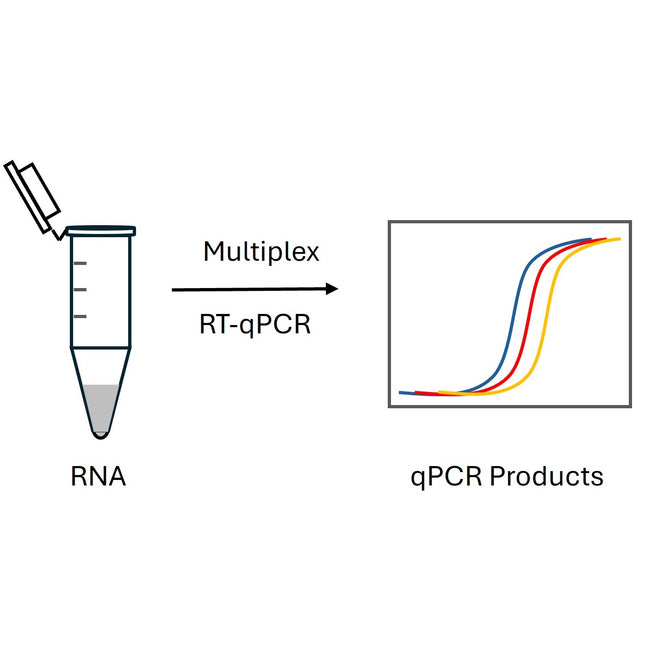
2x 1-Step Multiplex RT-qPCR Mastermix for TaqMan Probe (No ROX)
SKU: RTQM01-00Features The kit is designed for multiplex RT-qPCR with TaqMan probes. For the reverse transcription step, this kit uses a highly efficient Thermstable Reverse Transcriptase, a thermophilic type A polymerase, with optimal temperatures of 60-62°C. The RTase is easily heat-inactivated at ≥90°C for 1min. The RTase efficiently synthesizes complementary DNA strands on RNA templates from gene-specific primers, ≥1 unit per 20μL of reaction. The RTase reversely-transcribes single digit copies of target RNA molecules consistently. The kit also contains Taq-Probe DNA polymerase, specially engineered for TaqMan probes and generating S-shaped curves. Up to four pairs of gene-specific primers can be applied in one reaction. The concentrations of the primers and probes are variable depending on assay designs and thermocycling protocols (Table 1). The preferable PCR product size is ≤150bp. The kit has three formulations of No ROX, Low ROX or High ROX concentration for your choice (Table 4). Intended Use The 2x 1-Step Multiplex RT qPCR Master Mix is used for real-time qualitative and quantitative multiplex qPCR with TaqMan probes for up to four targets. The master mix is a premixed, 2X concentrated solution that has all the components except for gene-specific primers, probes and RNA templates. The kit can also be applied to extraction-free RNA of cultured cells. Transportation and storage The kit can be transported at below 4°C for up to 3 days. The kit should be kept stable in the dark at -20°C for ≤24 months with ≤10 times of freeze-thaw cycles. The kit can be stored at 4°C for a week. Setup Reaction and Thermocycling Thaw 1-Step 2X RT-PCR Master Mix and other reaction components at room temperature, mix each component, centrifuge and then place on ice. Set up reactions (Table 1). Seal tubes with flat, optically transparent caps or seal plate with optically transparent film. Mix and then briefly centrifuge the tubes or plate. Program PCR instrument with indicated thermo-cycling protocol. Load PCR tubes or plate and start to run. Perform data analysis according to the PCR instrument instructions. Table 1. Setting up a 20μl or 10μl Reaction Component Volume per 20μl Volume per 10μl Final Concentration 2x Mastermix 10μL 5μL 1X Primersa Variable Variable Each 150-400nM TaqMan probesb Variable Variable Each 150-250nM DNA Templatec Variable Variable ≤500ng human genomic DNA/20μL H2O To 20μL To 10μL Note: Each primer’s Tm should be designed ≥60°C, preferably between 62°C to 65°C, using primer3 software for high efficiency and specificity. Each probe’s Tm should be 8-10°C higher than the primer’s Tm, preferably between 70-75°C. DNA templates should be extracted by a qualified silica-based kit and eluted with low EDTA TE buffer (10mM Tris-HCl, 0.1mM EDTA, pH 8.0-8.3). Table 2. Standard Thermocycling Protocol Stage Temperature Period Number of Cycles I 60°C 10 min 1 II 95°C 1 min 1 III 95°C 10 sec 35-40 III 60°C, signal acquisition 60sec 35-40 Table 3. Three-Step Thermocycling Protocol Stage Temperature Period Number of Cycles I 60°C 10 min 1 II 95°C 1 min 1 III 95°C 10 sec 35-40 III 60°C 30 sec 35-40 III 68-72°C, signal acquisition 30 sec 35-40 Notes: The three-step thermocycling protocol in Table 4 increases overall polymerase activity by 50%, a more effective protocol than Table 3. The primer concentration used in Tables 3 and 4 is typically 0.15-0.2uM. Precautions If you order a “No ROX” master mix but you have an Applied Biosystems or Thermo Fisher instrument, please turn off ROX passive reference dye button when setup assays. Table 4. Compatible Instruments qPCR Instrument ROX required by instrument Passive dye setup Bio-Rad® iQ™5, CFX96, CFX384, Opticon, Roche Lightcycler®Qiagen Rotor-Gene™Eppendorf Mastercycler®Cepheid® SmartCycler® Not recommended Not necessary Applied Biosystems® 7500, 7500 Fast, QuantStudio™, ViiA7™, Agilent Mx™ Low ROX(50nM final concentration) Turn on ROX passive reference dye Applied Biosystems® 5700, 7000, 7300, 7700, 7900, 7900HT, 7900HT Fast, StepOne™, StepOnePlus™ High ROX(500nM final concentration) Turn on ROX passive reference dye
$180.00 - $7,290.00
-

2x 1-Step RT-qPCR Mastermix (No ROX)
SKU: RTQ01-00Kit Features The kit is designed for singleplex RT-PCR with SYBR Green dye. For the reverse transcription step, this kit uses a highly efficient Thermophilic Reverse Transcriptase, which is a thermophilic type A polymerase, with optimal temperatures of 60-62°C. The RTase is easily heat-inactivated at ≥90°C for 1min. The RTase efficiently synthesizes a complementary DNA strand on RNA template from a gene-specific primer, ≤1 unit per 20μL of reaction. The RTase reversely-transcribes single digit copies of target RNA molecules consistently. The kit also contains Taq DNA polymerase for PCR with SYBR Green dye. The concentrations of the primers are variable depending on assay designs and thermocycling protocols (Table 1). The preferable PCR product size is ≤150bp. The kit has three formulations of ROX, Low ROX or High ROX concentrations for your choice. Transportation and Storage The kit can be transported at below 4°C for up to 3 days. The kit should be kept stable in the dark at -20°C for ≤24 months with ≤10 times of freeze-thaw cycles. The kit can be stored at 4°C for a weak. Setup Reaction and Thermocycling Thaw 1-Step 2X RT-PCR Master Mix and other reaction components at room temperature, mix each component, centrifuge and then place on ice. Determine the total volume for the number of reactions, add 5-10% extra volume, and prepare assay mix of all components except RNA template. Mix the assay mix, centrifuge and then place on ice. Aliquot the assay mix into PCR tubes or plate. Add RNA template to PCR tubes or plate. Seal tubes with flat, optically transparent caps or seal plates with optically transparent film. Mix and then briefly centrifuge the tubes or plate. Program PCR instrument with indicated thermo-cycling protocol. Load PCR tubes or plate and start to run. Perform data analysis according to the PCR instrument instructions. Table 1. Setting up a 20μl or 10μl Reaction Component Volume per 20μl Volume per 10μl Final Concentration 2x Mastermix 10μL 5μL 1X Primersa Variable Variable Each 150-900nM RNA Templatesb Variable Variable As low as single digit copies of target RNA to ≤1μg total RNA H2O To 20μL To 10μL Note: Each primer’s Tm should be designed ≥60°C, preferably between 62°C to 65°C, using primer3 software for high efficiency and specificity. RNA templates should be extracted by a qualified silica-based kit and eluted with low EDTA TE buffer (10mM Tris-HCl, 0.1mM EDTA, pH 8.0-8.3). Table 2. Standard Thermocycling Protocol Stage Temperature Period Number of Cycles I 60°C 10min 1 II 95°C 1min 1 III 95°C 10sec 35-40 III 60°C, signal acquisition 60sec 35-40 IV 60°C to 95°C Various 1 Table 3. Three-Step Thermocycling Protocol Stage Temperature Period Number of Cycles I 60°C 10min 1 II 95°C 1min 1 III 95°C 10sec 35-40 III 60°C 30sec 35-40 III 68-72°C, signal acquisition 30sec 35-40 IV 68°C to 95°C Various 1 Notes: The three-step thermocycling protocol in Table 3 increases overall polymerase activity by 50%, a more effective protocol than Table 2. The primer concentration used in Tables 2 and 3 is typically 0.15-0.2uM. Table 4. Compatible Instruments qPCR Instrument ROX required by instrument Passive dye setup Bio-Rad® iQ™5, CFX96, CFX384, OpticonRoche Lightcycler®Qiagen Rotor-Gene™Eppendorf Mastercycler®Cepheid® SmartCycler® Not recommended Not necessary Applied Biosystems® 7500, 7500 Fast, QuantStudio™, ViiA7™, Agilent Mx™ Low ROX(50nM final concentration) Turn on ROX passive reference dye Applied Biosystems® 5700, 7000, 7300, 7700, 7900, 7900HT, 7900HT Fast, StepOne™, StepOnePlus™ High ROX(500nM final concentration) Turn on ROX passive reference dye Precautions If you order a “No ROX” master mix but you have an Applied Biosystems or Thermo Fisher instrument, please turn off ROX passive reference dye button when setup assays.
$180.00 - $4,055.00
-
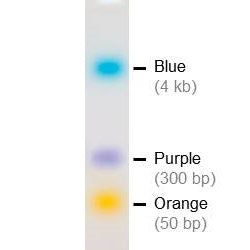
2x DNA Loading Buffer (10 ml)
SKU: DSB02-022X DNA Loading Buffer is a Ficoll 400-based ready-to-use DNA loading dye for tracking DNA migration during electrophoresis. 2X DNA Loading Buffer contains three dyes with different migration pattern: xylene cyanol FF migrates at approximately 4kb (Blue), bromophenol blue at 300bp (Purple) and orange G at 50bp (Orange) on a 1% agarose gel. Storage: Room temperature or 4 °C
$25.00
-
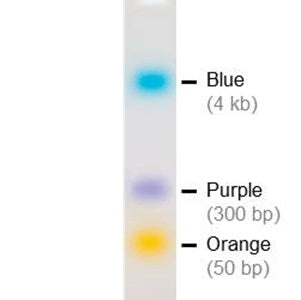
2x DNA Loading Buffer (5x1 ml)
SKU: DSB02-012X DNA Loading Buffer is a Ficoll 400-based ready-to-use DNA loading dye for tracking DNA migration during electrophoresis. 2X DNA Loading Buffer contains three dyes with different migration pattern: xylene cyanol FF migrates at approximately 4kb (Blue), bromophenol blue at 300bp (Purple) and orange G at 50bp (Orange) on a 1% agarose gel. Storage: Room temperature or 4 °C
$15.00
-

2x Fast qPCR Master Mix (High ROX)
SKU: QP13-00Intended Use The 2x Fast qPCR Mastermix is used for real-time qualitative and quantitative qPCR with SYBR Green dye. ; The Mastermix is a premixed, 2x concentrated solution that has all the components except for gene-specific primers, probes and templates Kit Characterizations The kit is designed for a single gene qPCR with SYBR Green dye. The kit contains Taq-Fast DNA polymerase which can extend more than 300 bases with a short cycling program. The concentrations of the primers and probes are variable depending on specific assays and thermocycling protocols (Table 1). The preferable PCR product size is ≤150bp. The kit has three formulations of No ROX, Low ROX or High ROX concentrations for corresponding instruments(see Table 4). Transportation and storage The kit can be transported at below 4°C for up to 3 days. The kit should be kept stable in the dark at -20°C for ≤24 months with ≤10 times of freeze-thaw cycles. The kit can be stored at 4°C for a week. Setup Reaction and Thermocycling Thaw 2x Mastermix and other reaction components at room temperature, mix each component, centrifuge and then place on ice. Set up reactions (Table 1). Seal tubes with flat, optically transparent caps or seal plate with optically transparent film. Mix and then briefly centrifuge the tubes or plate. Program PCR instrument with indicated thermo-cycling protocol. Load PCR tubes or plate and start to run. Perform data analysis according to the PCR instrument instructions. Table 1. Setting up a 20μl or 10μl Reaction Component Volume per 20μl Volume per 10μl Final Concentration 2x Mastermix 10μL 5μL 1X Primersa Variable Variable Each 150-900nM DNA Templateb Variable Variable ≤30ng genomic DNA/10μL H2O To 20μL To 10μL Note: Each primer’s Tm should be designed ≥60°C, preferably between 62°C to 65°C, using primer3 software for high efficiency and specificity. DNA templates should be extracted by a qualified silica-based kit and eluted with low EDTA TE buffer (10mM Tris-HCl, 0.1mM EDTA, pH 8.0-8.3). Table 2. Standard Thermocycling Protocol Stage Temperature Period Number of Cycles I 95°C 2 min 1 II 95°C 12 sec 35-40 II 60°C, signal acquisition 60 sec 35-40 III 60°C to 95°C Various 1 Note: The primer concentration used is typically 0.2uM Table 3. Fast Thermocycling Protocol Stage Temperature Period Number of Cycles I 95°C 1 min 1 II 95°C 5 sec 35-40 II 60°C, signal acquisition 30 sec 35-40 III 60°C to 95°C Various 1 Note: The product size for the fast thermocycling protocol is preferred to be less than 90bp. The primer concentration used is typically between 0.4uM and 0.9uM. Table 4. Compatible Instruments qPCR Instrument ROX required by instrument Passive dye setup Bio-Rad® iQ™5, CFX96, CFX384, Opticon Roche Lightcycler®Qiagen Rotor-Gene™Eppendorf Mastercycler®Cepheid® SmartCycler® Not recommended Not necessary Applied Biosystems® 7500, 7500 Fast, QuantStudio™, ViiA7™, Agilent Mx™ Low ROX(50nM final concentration) Turn on ROX passive reference dye Applied Biosystems® 5700, 7000, 7300, 7700, 7900, 7900HT, 7900HT Fast, StepOne™, StepOnePlus™ High ROX(500nM final concentration) Turn on ROX passive reference dye Quality Control Not detectable DNase and RNase contaminations. Precautions If you order a “No ROX” master mix but you have an Applied Biosystems or ThermoFisher instrument, please turn off ROX passive reference dye button when setup assays.
$70.00 - $2,150.00
-
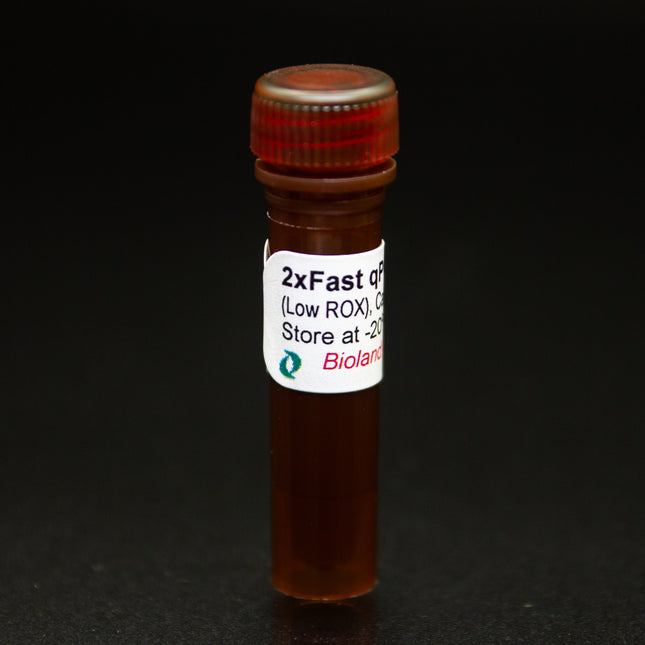
2x Fast qPCR Master Mix (Low ROX)
SKU: QP12-00Intended Use The 2x Fast qPCR Mastermix is used for real-time qualitative and quantitative qPCR with SYBR Green dye. ; The Mastermix is a premixed, 2x concentrated solution that has all the components except for gene-specific primers, probes and templates Kit Characterizations The kit is designed for a single gene qPCR with SYBR Green dye. The kit contains Taq-Fast DNA polymerase which can extend more than 300 bases with a short cycling program. The concentrations of the primers and probes are variable depending on specific assays and thermocycling protocols (Table 1). The preferable PCR product size is ≤150bp. The kit has three formulations of No ROX, Low ROX or High ROX concentrations for corresponding instruments(see Table 4). Transportation and storage The kit can be transported at below 4°C for up to 3 days. The kit should be kept stable in the dark at -20°C for ≤24 months with ≤10 times of freeze-thaw cycles. The kit can be stored at 4°C for a week. Setup Reaction and Thermocycling Thaw 2x Mastermix and other reaction components at room temperature, mix each component, centrifuge and then place on ice. Set up reactions (Table 1). Seal tubes with flat, optically transparent caps or seal plate with optically transparent film. Mix and then briefly centrifuge the tubes or plate. Program PCR instrument with indicated thermo-cycling protocol. Load PCR tubes or plate and start to run. Perform data analysis according to the PCR instrument instructions. Table 1. Setting up a 20μl or 10μl Reaction Component Volume per 20μl Volume per 10μl Final Concentration 2x Mastermix 10μL 5μL 1X Primersa Variable Variable Each 150-900nM DNA Templateb Variable Variable ≤30ng genomic DNA/10μL H2O To 20μL To 10μL Note: Each primer’s Tm should be designed ≥60°C, preferably between 62°C to 65°C, using primer3 software for high efficiency and specificity. DNA templates should be extracted by a qualified silica-based kit and eluted with low EDTA TE buffer (10mM Tris-HCl, 0.1mM EDTA, pH 8.0-8.3). Table 2. Standard Thermocycling Protocol Stage Temperature Period Number of Cycles I 95°C 2 min 1 II 95°C 12 sec 35-40 II 60°C, signal acquisition 60 sec 35-40 III 60°C to 95°C Various 1 Note: The primer concentration used is typically 0.2uM Table 3. Fast Thermocycling Protocol Stage Temperature Period Number of Cycles I 95°C 1 min 1 II 95°C 5 sec 35-40 II 60°C, signal acquisition 30 sec 35-40 III 60°C to 95°C Various 1 Note: The product size for the fast thermocycling protocol is preferred to be less than 90bp. The primer concentration used is typically between 0.4uM and 0.9uM. Table 4. Compatible Instruments qPCR Instrument ROX required by instrument Passive dye setup Bio-Rad® iQ™5, CFX96, CFX384, Opticon Roche Lightcycler®Qiagen Rotor-Gene™Eppendorf Mastercycler®Cepheid® SmartCycler® Not recommended Not necessary Applied Biosystems® 7500, 7500 Fast, QuantStudio™, ViiA7™, Agilent Mx™ Low ROX(50nM final concentration) Turn on ROX passive reference dye Applied Biosystems® 5700, 7000, 7300, 7700, 7900, 7900HT, 7900HT Fast, StepOne™, StepOnePlus™ High ROX(500nM final concentration) Turn on ROX passive reference dye Quality Control Not detectable DNase and RNase contaminations. Precautions If you order a “No ROX” master mix but you have an Applied Biosystems or ThermoFisher instrument, please turn off ROX passive reference dye button when setup assays.
$60.00 - $2,000.00
-
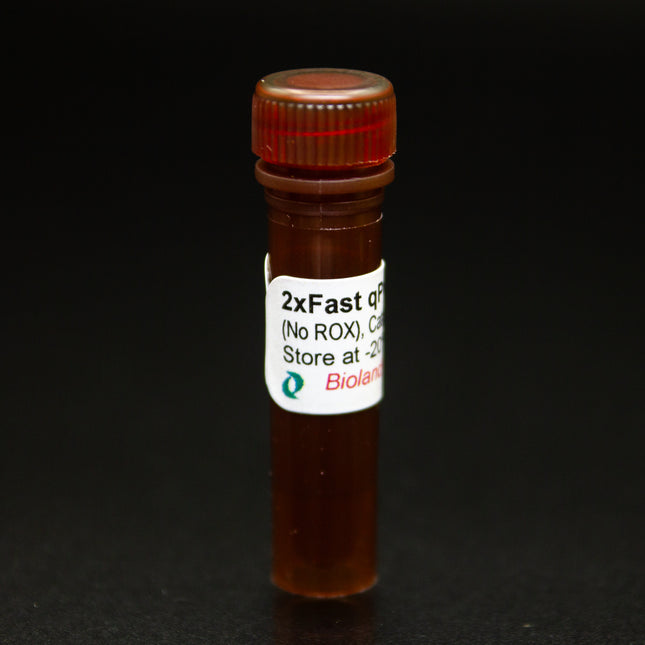
2x Fast qPCR Master Mix (No ROX)
SKU: QP11-00Intended Use The 2x Fast qPCR Mastermix is used for real-time qualitative and quantitative qPCR with SYBR Green dye. ; The Mastermix is a premixed, 2x concentrated solution that has all the components except for gene-specific primers, probes and templates Kit Characterizations The kit is designed for a single gene qPCR with SYBR Green dye. The kit contains Taq-Fast DNA polymerase which can extend more than 300 bases with a short cycling program. The concentrations of the primers and probes are variable depending on specific assays and thermocycling protocols (Table 1). The preferable PCR product size is ≤150bp. The kit has three formulations of No ROX, Low ROX or High ROX concentrations for corresponding instruments(see Table 4). Transportation and storage The kit can be transported at below 4°C for up to 3 days. The kit should be kept stable in the dark at -20°C for ≤24 months with ≤10 times of freeze-thaw cycles. The kit can be stored at 4°C for a week. Setup Reaction and Thermocycling Thaw 2x Mastermix and other reaction components at room temperature, mix each component, centrifuge and then place on ice. Set up reactions (Table 1). Seal tubes with flat, optically transparent caps or seal plate with optically transparent film. Mix and then briefly centrifuge the tubes or plate. Program PCR instrument with indicated thermo-cycling protocol. Load PCR tubes or plate and start to run. Perform data analysis according to the PCR instrument instructions. Table 1. Setting up a 20μl or 10μl Reaction Component Volume per 20μl Volume per 10μl Final Concentration 2x Mastermix 10μL 5μL 1X Primersa Variable Variable Each 150-900nM DNA Templateb Variable Variable ≤30ng genomic DNA/10μL H2O To 20μL To 10μL Note: Each primer’s Tm should be designed ≥60°C, preferably between 62°C to 65°C, using primer3 software for high efficiency and specificity. DNA templates should be extracted by a qualified silica-based kit and eluted with low EDTA TE buffer (10mM Tris-HCl, 0.1mM EDTA, pH 8.0-8.3). Table 2. Standard Thermocycling Protocol Stage Temperature Period Number of Cycles I 95°C 2 min 1 II 95°C 12 sec 35-40 II 60°C, signal acquisition 60 sec 35-40 III 60°C to 95°C Various 1 Note: The primer concentration used is typically 0.2uM Table 2. Standard Thermocycling Protocol Stage Temperature Period Number of Cycles I 95°C 1 min 1 II 95°C 5 sec 35-40 II 60°C, signal acquisition 30 sec 35-40 III 60°C to 95°C Various 1 Note: The product size for the fast thermocycling protocol is preferred to be less than 90bp. The primer concentration used is typically between 0.4uM and 0.9uM. Table 4. Compatible Instruments qPCR Instrument ROX required by instrument Passive dye setup Bio-Rad® iQ™5, CFX96, CFX384, Opticon Roche Lightcycler®Qiagen Rotor-Gene™Eppendorf Mastercycler®Cepheid® SmartCycler® Not recommended Not necessary Applied Biosystems® 7500, 7500 Fast, QuantStudio™, ViiA7™, Agilent Mx™ Low ROX(50nM final concentration) Turn on ROX passive reference dye Applied Biosystems® 5700, 7000, 7300, 7700, 7900, 7900HT, 7900HT Fast, StepOne™, StepOnePlus™ High ROX(500nM final concentration) Turn on ROX passive reference dye Quality Control Not detectable DNase and RNase contaminations. Precautions If you order a “No ROX” master mix but you have an Applied Biosystems or ThermoFisher instrument, please turn off ROX passive reference dye button when setup assays.
$60.00 - $2,000.00
-
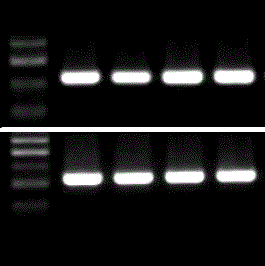
2x HiFi PCR Mix for NGS
SKU: NGHTP01-01Description HiFi PCR Mix for NGS is a premixed system consisting of hot-start enzyme, PCR Buffer, dNTPs, Mg2+, and PCR stabilizers and enhancers. It has high fidelity, high extensibility, and low preference. For complex DNA templates (such as high GC content template), it has a balanced amplification efficiency. This product is particularly suitable for the amplification of multiplex PCR during the construction of NGS library. The highly efficient hot-start enzyme contained in this product does not have polymerase activity at room temperature, thus effectively avoiding non-specific amplification. The combination of a unique buffer system and a hot-start enzyme significantly improves the efficiency of the PCR, resulting in a wider range of amplification. This product effectively increases the amplification efficiency of high GC or high AT regions in the genome, reduces the amplification preference and increases the coverage area of sequencing. Precautions This product cannot use with primers with modifications. Invert gently to mix well before use. Avoid foaming. Use after brief centrifuge. Avoid freezing and thawing repeatedly. Repeated freezing and thawing will comprise the performance of this product. Store at 2-8°C if used frequently.
$175.00 - $509.00












